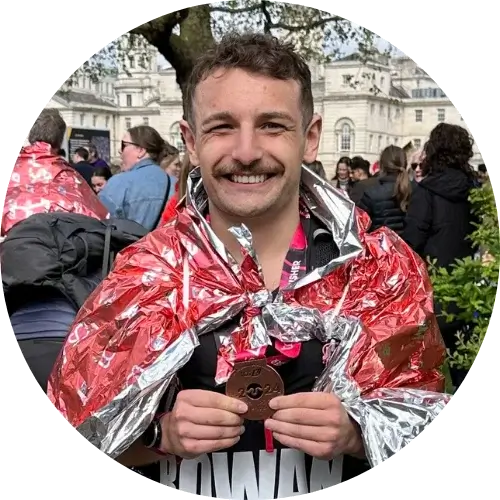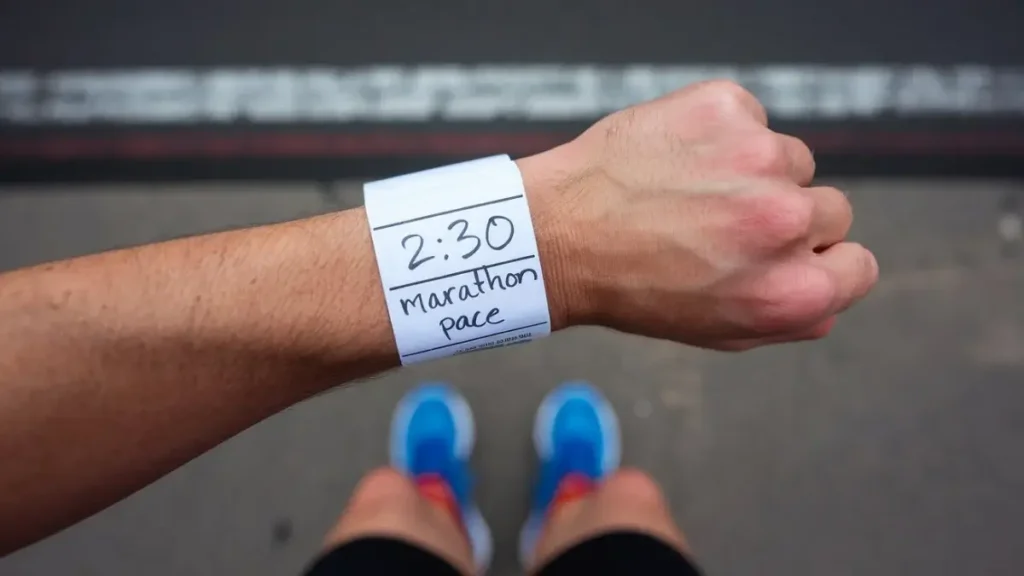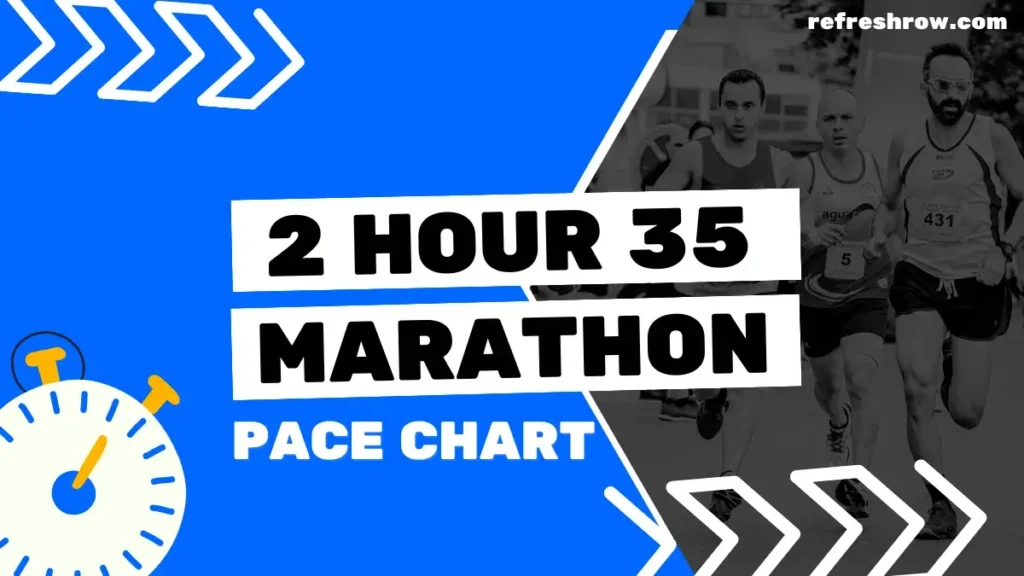To run a 7:00 hour marathon you need to run at a pace of 16:10 per mile or 9:57 per kilometer.
Following the splits below (and shaving off a second), you’ll run a sub 7:00 marathon.
I’d recommend aiming to run 1-2 minutes ahead of the split target time from 10 miles, as you’ll likely come up against crowding on race day.
7:00 Marathon Pace in Miles
| Mile | Split |
|---|---|
| 1 | 16:01 |
| 2 | 32:02 |
| 3 | 48:03 |
| 4 | 1:04:04 |
| 5 | 1:20:05 |
| 6 | 1:36:06 |
| 7 | 1:52:07 |
| 8 | 2:08:09 |
| 9 | 2:24:10 |
| 10 | 2:40:11 |
| 11 | 2:56:12 |
| 12 | 3:12:13 |
| 13 | 3:28:14 |
| 14 | 3:44:15 |
| 15 | 4:00:17 |
| 16 | 4:16:18 |
| 17 | 4:32:19 |
| 18 | 4:48:20 |
| 19 | 5:04:21 |
| 20 | 5:20:22 |
| 21 | 5:36:23 |
| 22 | 5:52:24 |
| 23 | 6:08:26 |
| 24 | 6:24:27 |
| 25 | 6:40:28 |
| 26 | 6:56:29 |
| 26.2 | 7:00:00 |
Download
7:00 Marathon Pace in KM
| KM | Split |
|---|---|
| 1 | 9:57 |
| 2 | 19:54 |
| 3 | 29:52 |
| 4 | 39:49 |
| 5 | 49:46 |
| 6 | 59:44 |
| 7 | 1:09:41 |
| 8 | 1:19:38 |
| 9 | 1:29:36 |
| 10 | 1:39:33 |
| 11 | 1:49:30 |
| 12 | 1:59:28 |
| 13 | 2:09:25 |
| 14 | 2:19:22 |
| 15 | 2:29:20 |
| 16 | 2:39:17 |
| 17 | 2:49:14 |
| 18 | 2:59:12 |
| 19 | 3:09:09 |
| 20 | 3:19:06 |
| 21 | 3:29:04 |
| 22 | 3:39:01 |
| 23 | 3:48:59 |
| 24 | 3:58:56 |
| 25 | 4:08:53 |
| 26 | 4:18:51 |
| 27 | 4:28:48 |
| 28 | 4:38:45 |
| 29 | 4:48:43 |
| 30 | 4:58:40 |
| 31 | 5:08:37 |
| 32 | 5:18:35 |
| 33 | 5:28:32 |
| 34 | 5:38:29 |
| 35 | 5:48:27 |
| 36 | 5:58:24 |
| 37 | 6:08:21 |
| 38 | 6:18:19 |
| 39 | 6:28:16 |
| 40 | 6:38:13 |
| 41 | 6:48:11 |
| 42 | 6:58:08 |
| 42.2 | 7:00:00 |
Download
Other Marathon Pace Charts
Targeting a different time?
Check out the Full Marathon Pace Chart in Miles or KM
Or select a specific finishing time below:
| 3:00 | 4:00 | 5:00 | |
| 3:05 | 4:05 | 5:15 | |
| 3:10 | 4:10 | 5:30 | |
| 3:15 | 4:15 | 5:45 | |
| 3:20 | 4:20 | 6:00 | |
| 3:25 | 4:25 | 6:15 | |
| 2:30 | 3:30 | 4:30 | 6:30 |
| 2:35 | 3:35 | 4:35 | 6:45 |
| 2:40 | 3:40 | 4:40 | 7:00 |
| 2:45 | 3:45 | 4:45 | |
| 2:50 | 3:50 | 4:50 | |
| 2:55 | 3:55 | 4:55 |
Training for a 7:00 Marathon
Is 7:00 a Good Marathon Time?
Well, what do the stats say?
Run Repeat conducted a study that contains 19,614,975 marathon results from more than 32,335 races across the globe, here is how a 7:00 marathon compares against age and gender for the races recorded:
| Overall | You’re faster than 1.4% of all runners. |
| Male | You’re faster than 1.1% of males. |
| Female | You’re faster than 1.9% of females. |
| <20 | You’re faster than 2.9% of under 20s. |
| 20-29 | You’re faster than 1.0% of 20-29 year olds. |
| 30-39 | You’re faster than 0.9% of 30-39 year olds. |
| 40-49 | You’re faster than 1.0% of 40-49 year olds. |
| 50-59 | You’re faster than 1.6% of 50-59 year olds. |
| >60 | You’re faster than 4.3% of over 60s. |
Training Runs and Paces for a 7:00 Marathon
To break a 7:00 marathon you’ll need to do some serious distance in your training, I recommend at least 10 miles (16km) per week.
You’re also going to need to make sure you’ve crossed off these milestones for other race distances:
- A 5k in 43:35
- A 10k in 1:31:40
- A half marathon in 3:12:00
Training Paces
| Pace | Mins per Mile | Mins per KM |
|---|---|---|
| Easy | 18:03 | 11:13 |
| Steady | 16:02 | 9:57 |
| 10k | 14:41 | 9:07 |
| 5k | 14:05 | 8:45 |
| 1 Mile | 13:05 | 8:10 |
Weekly Mileage Targets
| Target Mileage: | Gradually increase your weekly mileage from 6 miles (10 km) to a peak of 12 miles (19 km). |
| Incremental Increase: | Increase mileage by approximately 10% each week, with every fourth week as a recovery week where mileage is reduced by 20-30%. Make sure to taper for the last 1-2 weeks. |
Long Run Structure
| Total Distance: | Build up to long runs of 8-9 miles (13-14.5 km). |
| Segment Example: | First 3 miles (5 km): Easy pace, heart rate 140-150 bpm (approximately 18:30/mile or 11:29/km). Next 1 mile (1.6 km): Fast pace at 12:45/mile (7:56/km). Next 2 miles (3.2 km): Medium effort, heart rate around 160 bpm (approximately 13:50/mile or 8:35/km). Final 3 miles (5 km): Return to easy pace at 18:30/mile (11:29/km). |
Why This Works: Incorporating varied paces within long runs enhances lactate tolerance, which helps on race day when you’ve got to maintain pace despite feeling fatigued. By practicing surges during a run, you can build up your physical and mental resilience (lots of elite marathon runners use these strategies during their training)
Alternating Long Runs: Alternate between structured long runs (easy/fast segments) and easier long runs. For easier long runs, maintain a steady, comfortable pace throughout, focusing on mileage rather than speed to aid recovery.
Speedwork Sessions
| Short Intervals: | – 400m repeats at 6:10 per interval (7:39/km). – Aim for 3-4 repetitions with equal time for recovery. |
| Mile Repeats: | – 1 mile repeats at 12:45 per mile (7:56/km). – Aim for 2-3 repetitions with a 1-2 minute recovery jog. |
| Longer Intervals: | – 2 mile repeats at 13:00 per mile (8:04/km). – Aim for 2 repetitions with a 2-3 minute recovery jog. |
Recovery and Rest Days
| Rest Days: | Include 2 rest days per week to ensure your body has enough recovery time and avoids overtraining. |
| Easy Run Days: | Include 1-2 easy run days per week at a relaxed pace of 19:00/mile (11:48/km), covering 2-3 miles (3-5 km) per day. Try to keep your heart rate below 140 bpm on easy days to ensure proper recovery and aerobic development. |
My Tips to Run a Sub 7:00 Marathon
Personal Time Checkpoints Over Official Mile Markers
You might find that official mile markers start to feel more like discouragements rather than milestones.
When fatigue kicks in, it can play tricks on your mind and make the miles seem further and further apart.
Instead, you can create your own personal time checkpoints
Set your watch to vibrate every 30 minutes, and focus on just reaching that point.
This allows you to break the race into more digestible time-based segments rather than stressing about the whole overall distance.
And before you know it, you’ll be at the finish line;)
“Energy Swaps” with Fellow Runners
Make sure you put your expected race in correctly when you sign up for the marathon.
And you’ll be surrounded by a community of runners who are likely pacing themselves for a similar time, and can provide a massive boost.
Create an “energy swap” routine with fellow runners – this could be something as simple as offering a cheer, a thumbs-up, or a brief conversation at agreed-upon intervals (every 5 miles, for example).
A little human connection can go a long way in motivating both of you during tough sections of the course.
I really like this tactic, it’s super wholesome but also a very effective mental management technique, and you get to help those around you (good karma).
Plan an Emotional Recharge Zone
But sometimes the long grind of a seven-hour marathon can mean the physical and mental fatigue become too much, and you need to stop.
And that’s okay.
But let’s do it strategically.
Identify a specific point on the course where you know you’ll hit a low point (it could be around mile 18-22) and prepare an emotional recharge for this exact spot.
Whether it’s saving your favorite song for that moment, looking for a personal support crew, or planning a pep talk with yourself, having this emotional recharge can re-energize your mind and body for the final push.
Create a “Mental Cue” Playlist
Talking about music, many runners use it to stay motivated.
A default playlist can work great, but we can do more with it with a little bit of planning.
Instead, build a playlist where each song/genre triggers a mental cue for something for you to focus on.
E.g. choose one song/genre for controlled breathing, another to remind you to check your posture, and a third to help you loosen up your stride.
These specific cues, triggered by familiar songs/genres, can help you remain mentally sharp as fatigue sets in.
This is especially helpful when long hours on your feet can lead to forgetting basic techniques like proper form and breath control.
Top Tip: Only have one earbud in! You still want to hear the crowd’s cheers and take in the day so you’ve got the memories forever.


Row Brown is the founder of Refresh Row. He is a keen marathon runner, his favorite being the London Marathon. He’s now set himself the mission of Running the Entire Length of Spain, which is scheduled for late 2024.


